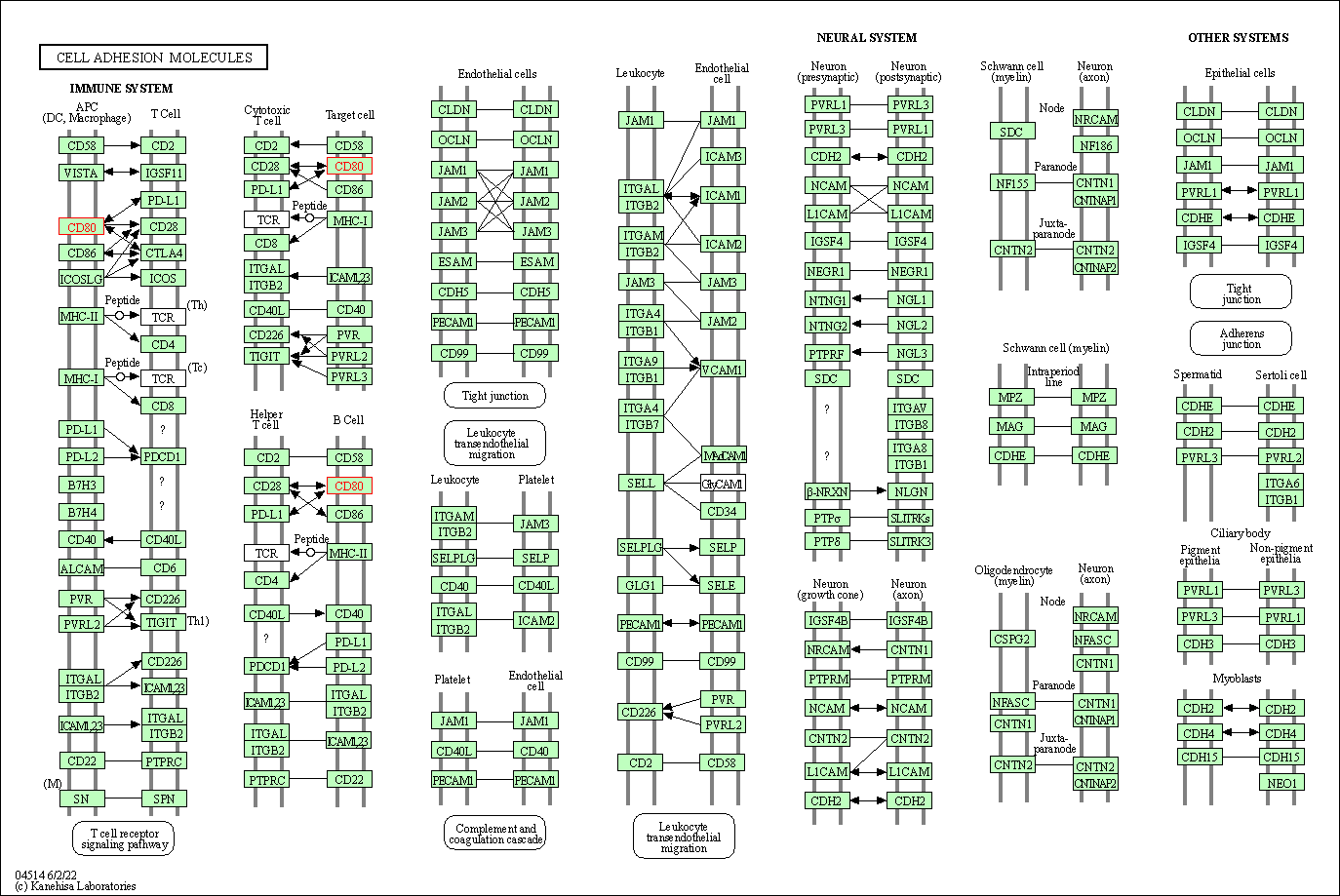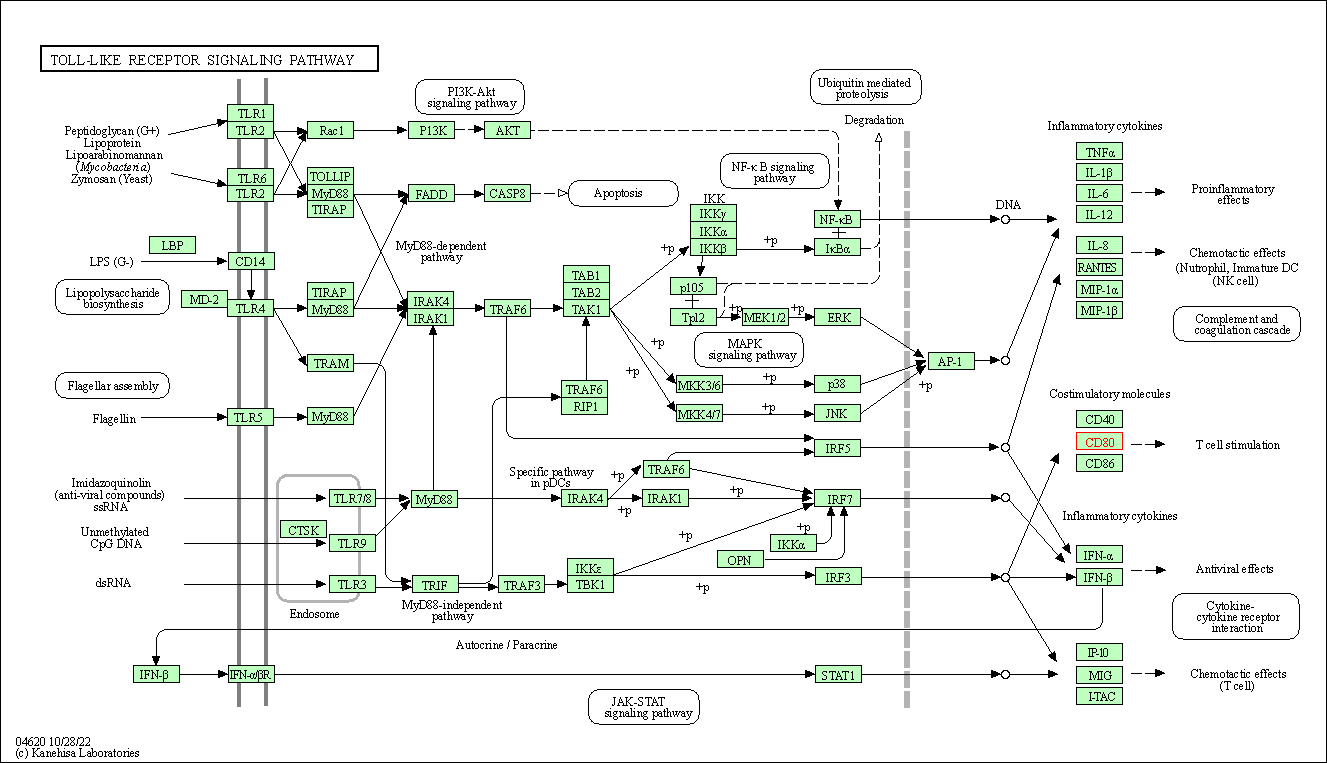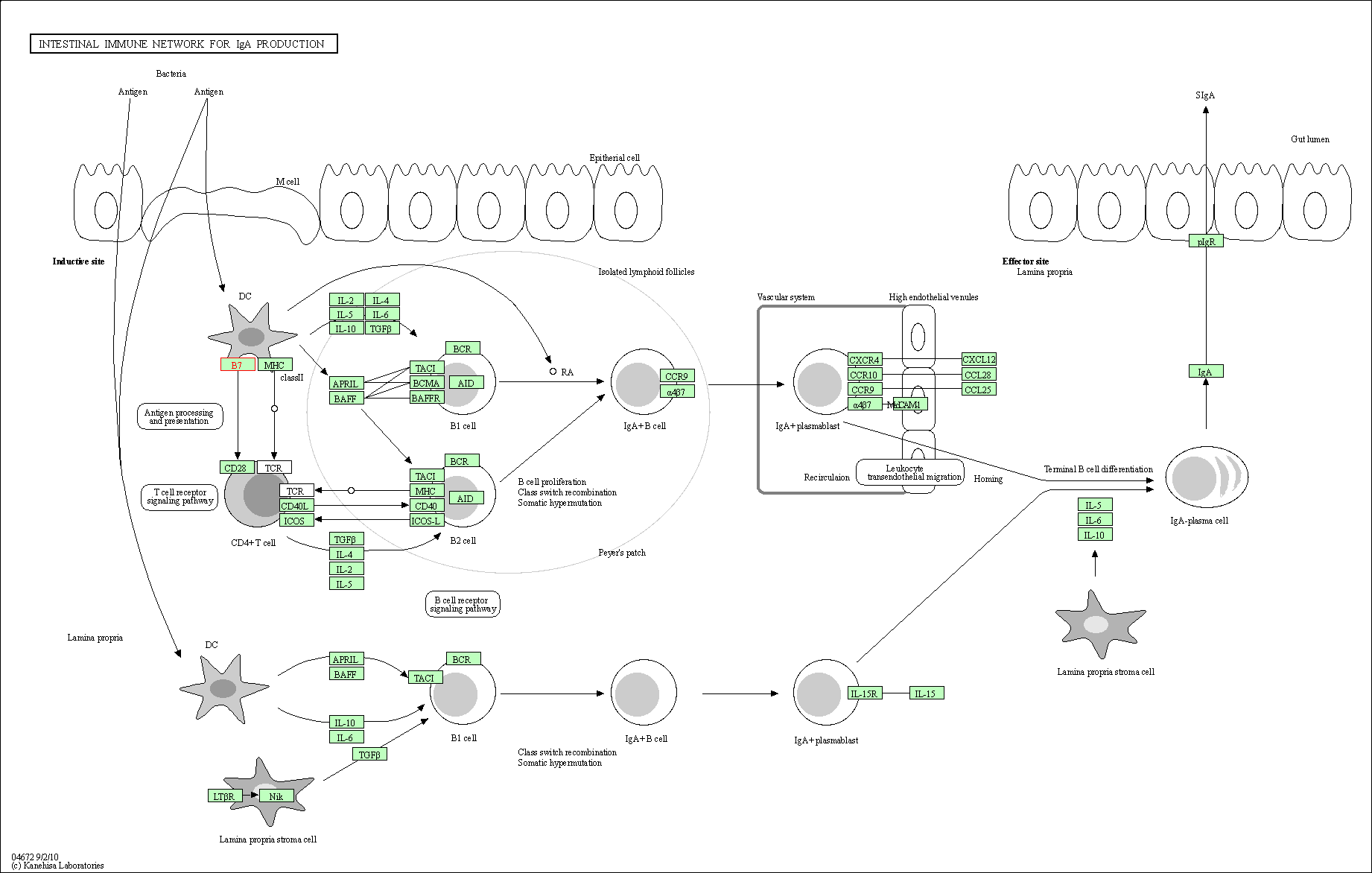Target Information
| Target General Information | Top | |||||
|---|---|---|---|---|---|---|
| Target ID |
T58238
(Former ID: TTDS00453)
|
|||||
| Target Name |
Activation B7-1 antigen (CD80)
|
|||||
| Synonyms |
T-lymphocyte activation antigen CD80; LAB7; CTLA-4 counter-receptor B7.1; CD28LG1; CD28LG; BB1; B7
Click to Show/Hide
|
|||||
| Gene Name |
CD80
|
|||||
| Target Type |
Successful target
|
[1] | ||||
| Disease | [+] 1 Target-related Diseases | + | ||||
| 1 | Rheumatoid arthritis [ICD-11: FA20] | |||||
| Function |
T-cell proliferation and cytokine production is induced by the binding of CD28, binding to CTLA-4 has opposite effects and inhibits T-cell activation. Involved in the costimulatory signal essential for T-lymphocyte activation.
Click to Show/Hide
|
|||||
| UniProt ID | ||||||
| Sequence |
MGHTRRQGTSPSKCPYLNFFQLLVLAGLSHFCSGVIHVTKEVKEVATLSCGHNVSVEELA
QTRIYWQKEKKMVLTMMSGDMNIWPEYKNRTIFDITNNLSIVILALRPSDEGTYECVVLK YEKDAFKREHLAEVTLSVKADFPTPSISDFEIPTSNIRRIICSTSGGFPEPHLSWLENGE ELNAINTTVSQDPETELYAVSSKLDFNMTTNHSFMCLIKYGHLRVNQTFNWNTTKQEHFP DNLLPSWAITLISVNGIFVICCLTYCFAPRCRERRRNERLRRESVRPV Click to Show/Hide
|
|||||
| 3D Structure | Click to Show 3D Structure of This Target | AlphaFold | ||||
| ADReCS ID | BADD_A02356 | |||||
| HIT2.0 ID | T23OTN | |||||
| Drugs and Modes of Action | Top | |||||
|---|---|---|---|---|---|---|
| Approved Drug(s) | [+] 1 Approved Drugs | + | ||||
| 1 | Abatacept | Drug Info | Approved | Rheumatoid arthritis | [2], [3], [4] | |
| Clinical Trial Drug(s) | [+] 5 Clinical Trial Drugs | + | ||||
| 1 | RhuDex | Drug Info | Phase 2a | Rheumatoid arthritis | [5] | |
| 2 | Galiximab | Drug Info | Phase 2 | Lymphoma | [6] | |
| 3 | HS-110 | Drug Info | Phase 2 | Non-small-cell lung cancer | [7] | |
| 4 | CAR-T cells targeting CD80/86 | Drug Info | Phase 1 | Solid tumour/cancer | [8] | |
| 5 | MAXY-4 | Drug Info | Phase 1 | Autoimmune diabetes | [9] | |
| Mode of Action | [+] 3 Modes of Action | + | ||||
| Binder | [+] 1 Binder drugs | + | ||||
| 1 | Abatacept | Drug Info | [1] | |||
| Inhibitor | [+] 2 Inhibitor drugs | + | ||||
| 1 | RhuDex | Drug Info | [11] | |||
| 2 | MAXY-4 | Drug Info | [14] | |||
| CAR-T-Cell-Therapy | [+] 1 CAR-T-Cell-Therapy drugs | + | ||||
| 1 | CAR-T cells targeting CD80/86 | Drug Info | [8] | |||
| Cell-based Target Expression Variations | Top | |||||
|---|---|---|---|---|---|---|
| Cell-based Target Expression Variations | ||||||
| Different Human System Profiles of Target | Top |
|---|---|
|
Human Similarity Proteins
of target is determined by comparing the sequence similarity of all human proteins with the target based on BLAST. The similarity proteins for a target are defined as the proteins with E-value < 0.005 and outside the protein families of the target.
A target that has fewer human similarity proteins outside its family is commonly regarded to possess a greater capacity to avoid undesired interactions and thus increase the possibility of finding successful drugs
(Brief Bioinform, 21: 649-662, 2020).
Human Pathway Affiliation
of target is determined by the life-essential pathways provided on KEGG database. The target-affiliated pathways were defined based on the following two criteria (a) the pathways of the studied target should be life-essential for both healthy individuals and patients, and (b) the studied target should occupy an upstream position in the pathways and therefore had the ability to regulate biological function.
Targets involved in a fewer pathways have greater likelihood to be successfully developed, while those associated with more human pathways increase the chance of undesirable interferences with other human processes
(Pharmacol Rev, 58: 259-279, 2006).
Biological Network Descriptors
of target is determined based on a human protein-protein interactions (PPI) network consisting of 9,309 proteins and 52,713 PPIs, which were with a high confidence score of ≥ 0.95 collected from STRING database.
The network properties of targets based on protein-protein interactions (PPIs) have been widely adopted for the assessment of target’s druggability. Proteins with high node degree tend to have a high impact on network function through multiple interactions, while proteins with high betweenness centrality are regarded to be central for communication in interaction networks and regulate the flow of signaling information
(Front Pharmacol, 9, 1245, 2018;
Curr Opin Struct Biol. 44:134-142, 2017).
Human Similarity Proteins
Human Pathway Affiliation
Biological Network Descriptors
|
|
| KEGG Pathway | Pathway ID | Affiliated Target | Pathway Map |
|---|---|---|---|
| Virion - Adenovirus | hsa03267 | Affiliated Target |

|
| Class: Genetic Information Processing => Information processing in viruses | Pathway Hierarchy | ||
| Cell adhesion molecules | hsa04514 | Affiliated Target |

|
| Class: Environmental Information Processing => Signaling molecules and interaction | Pathway Hierarchy | ||
| Toll-like receptor signaling pathway | hsa04620 | Affiliated Target |

|
| Class: Organismal Systems => Immune system | Pathway Hierarchy | ||
| Intestinal immune network for IgA production | hsa04672 | Affiliated Target |

|
| Class: Organismal Systems => Immune system | Pathway Hierarchy | ||
| Degree | 22 | Degree centrality | 2.36E-03 | Betweenness centrality | 4.91E-04 |
|---|---|---|---|---|---|
| Closeness centrality | 2.18E-01 | Radiality | 1.38E+01 | Clustering coefficient | 2.68E-01 |
| Neighborhood connectivity | 2.45E+01 | Topological coefficient | 8.77E-02 | Eccentricity | 12 |
| Download | Click to Download the Full PPI Network of This Target | ||||
| Target Regulators | Top | |||||
|---|---|---|---|---|---|---|
| Target-regulating microRNAs | ||||||
| Target-interacting Proteins | ||||||
| Target Profiles in Patients | Top | |||||
|---|---|---|---|---|---|---|
| Target Expression Profile (TEP) | ||||||
| Target-Related Models and Studies | Top | |||||
|---|---|---|---|---|---|---|
| Target Validation | ||||||
| References | Top | |||||
|---|---|---|---|---|---|---|
| REF 1 | Selective modulation of T-cell co-stimulation: a novel mode of action for the treatment of rheumatoid arthritis. Clin Exp Rheumatol. 2009 May-Jun;27(3):510-8. | |||||
| REF 2 | URL: http://www.guidetopharmacology.org Nucleic Acids Res. 2015 Oct 12. pii: gkv1037. The IUPHAR/BPS Guide to PHARMACOLOGY in 2016: towards curated quantitative interactions between 1300 protein targets and 6000 ligands. (Ligand id: 6891). | |||||
| REF 3 | Emerging drugs for idiopathic thrombocytopenic purpura in adults. Expert Opin Emerg Drugs. 2008 Jun;13(2):237-54. | |||||
| REF 4 | Clinical pipeline report, company report or official report of the Pharmaceutical Research and Manufacturers of America (PhRMA) | |||||
| REF 5 | New developments in immunosuppressive therapy for heart transplantation. Expert Opin Emerg Drugs. 2009 Mar;14(1):1-21. | |||||
| REF 6 | ClinicalTrials.gov (NCT00516217) Galiximab in Treating Patients With Relapsed or Refractory Hodgkin's Lymphoma. U.S. National Institutes of Health. | |||||
| REF 7 | ClinicalTrials.gov (NCT02117024) A Phase 2 Study of Viagenpumatucel-L (HS-110) in Patients With Non-Small Cell Lung Cancer. U.S. National Institutes of Health. | |||||
| REF 8 | ClinicalTrials.gov (NCT03198052) HER2/Mesothelin/Lewis-Y/PSCA/MUC1/PD-L1/CD80/86-CAR-T Cells Immunotherapy Against Cancers | |||||
| REF 9 | ClinicalTrials.gov (NCT02052375) A Study To Evaluate the Pharmacokinetics, Pharmacodynamics, Safety and Tolerability of ASP2408 After Multiple Dose Subcutaneous Injections in Patients With RheumatoidArthritis on Methotrexate. U.S. National Institutes of Health. | |||||
| REF 10 | Trusted, scientifically sound profiles of drug programs, clinical trials, safety reports, and company deals, written by scientists. Springer. 2015. Adis Insight (drug id 800011393) | |||||
| REF 11 | A phase 1 study of AS1409, a novel antibody-cytokine fusion protein, in patients with malignant melanoma or renal cell carcinoma. Clin Cancer Res. 2011 Apr 1;17(7):1998-2005. | |||||
| REF 12 | Phase I/II study of galiximab, an anti-CD80 antibody, for relapsed or refractory follicular lymphoma. J Clin Oncol. 2005 Jul 1;23(19):4390-8. | |||||
| REF 13 | Clinical pipeline report, company report or official report of Heat Biologics. | |||||
| REF 14 | Trans-endocytosis of CD80 and CD86: a molecular basis for the cell-extrinsic function of CTLA-4. Science. 2011 Apr 29;332(6029):600-3. | |||||
If You Find Any Error in Data or Bug in Web Service, Please Kindly Report It to Dr. Zhou and Dr. Zhang.

